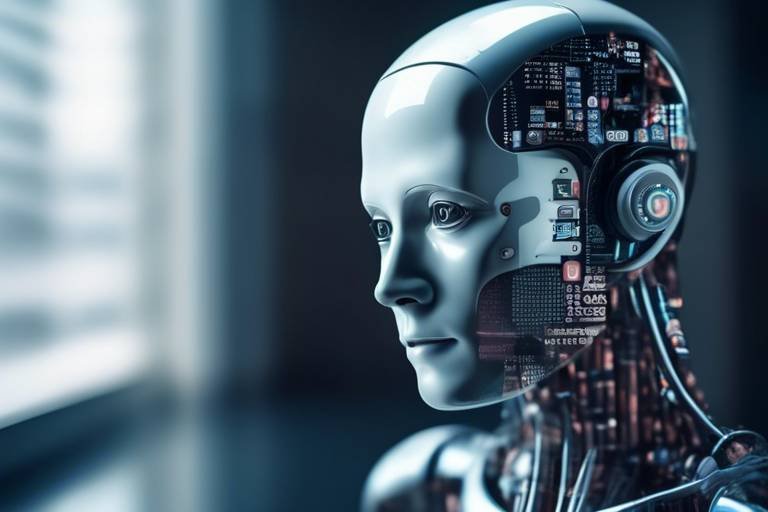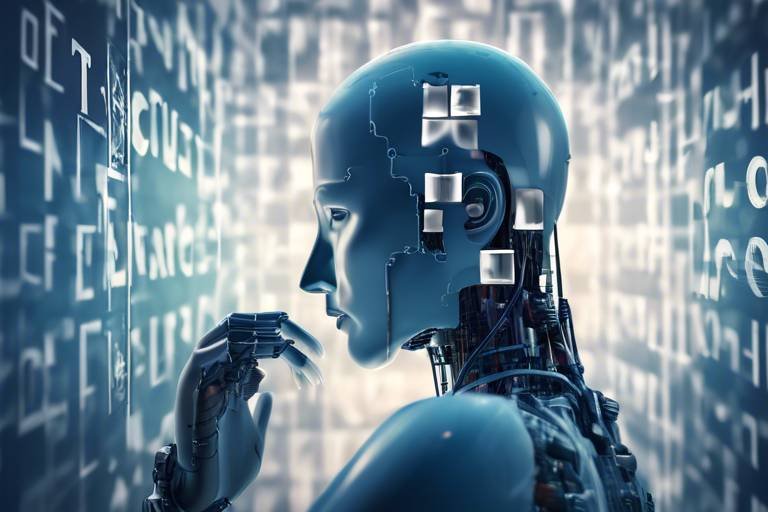Dismantling Barriers in AI with Ethics
In the rapidly evolving world of technology, artificial intelligence (AI) stands out as a game-changer. However, as we embrace this innovation, we must also confront a pivotal question: How do we ensure that AI serves humanity ethically and responsibly? The integration of ethics into AI development is not merely a suggestion; it is an imperative. This article delves into the significance of ethical considerations in AI, the challenges that hinder their implementation, and the solutions that can pave the way for a more just and equitable AI landscape.
Imagine AI as a powerful tool, much like a double-edged sword. On one side, it has the potential to solve complex problems, enhance productivity, and improve our quality of life. On the other, if wielded without ethical foresight, it can perpetuate biases, invade privacy, and amplify societal inequalities. Therefore, understanding and addressing the ethical implications of AI is crucial for shaping a future where technology uplifts rather than undermines our values.
As we navigate this intricate terrain, we must recognize that ethical AI is synonymous with fairness, accountability, and transparency. These principles are the cornerstones upon which we can build AI systems that not only respect individual rights but also contribute positively to society as a whole. By fostering an environment where ethics is prioritized, we can dismantle the barriers that currently exist in AI development and create solutions that are both innovative and responsible.
In the sections that follow, we will explore the multifaceted challenges organizations face in implementing ethical standards, from biases embedded in algorithms to the lack of regulatory frameworks. We will also discuss best practices that can guide developers and stakeholders in aligning AI technologies with ethical principles, ensuring that our advancements in AI are not just technologically sound but also morally grounded.

The Importance of Ethical AI
In today's rapidly advancing technological landscape, the significance of ethical considerations in artificial intelligence (AI) cannot be overstated. As we integrate AI into various aspects of our lives—from healthcare and finance to transportation and entertainment—understanding the ethical implications becomes crucial. Why, you may ask? Because ethical AI promotes fairness, accountability, and transparency, ensuring that these powerful systems serve the greater good rather than perpetuate inequality or harm.
Imagine a world where AI systems are designed with a moral compass, guiding decisions that impact millions. This isn't just a dream; it's a necessity. The integration of ethics into AI development shapes how technology interacts with society. By embedding ethical principles, we can create systems that respect human rights and dignity, ultimately fostering trust between AI and its users. Without these considerations, we risk building technologies that could reinforce existing biases or create new forms of discrimination.
Moreover, ethical AI is not merely about compliance; it's about responsibility. Organizations that prioritize ethical standards in AI development can significantly enhance their reputation and build stronger relationships with stakeholders. When consumers know that a company values ethics, they are more likely to engage with its products and services. This trust can lead to increased customer loyalty and a competitive edge in the marketplace.
To illustrate the importance of ethical AI, consider the following key benefits:
- Promotes Fairness: Ethical AI helps in mitigating biases, ensuring that decisions made by AI systems are just and equitable.
- Enhances Accountability: With ethical guidelines in place, organizations are more accountable for the outcomes of their AI technologies.
- Builds Trust: Transparency in AI processes fosters trust among users, encouraging them to embrace these technologies.
Ultimately, the importance of ethical AI lies in its ability to create a more equitable and responsible technology landscape. As we continue to innovate and expand the capabilities of AI, we must remember that these systems are tools created by humans, for humans. Therefore, it is our duty to ensure they reflect our values and aspirations as a society.

Challenges in Implementing Ethical Standards
In today's rapidly evolving technological landscape, the integration of ethical standards into artificial intelligence (AI) development is not just a lofty ideal—it's a necessity. However, the journey toward ethical AI is fraught with challenges that can hinder progress and compromise the integrity of these systems. The complexities of AI technology, combined with various social, economic, and political factors, create a perfect storm of obstacles that organizations must navigate. So, what are these challenges, and how can we overcome them?
One of the most pressing issues is the **lack of a universal definition** of what ethical AI truly means. Different stakeholders, including developers, policymakers, and users, often have varying interpretations of ethics, leading to inconsistencies in implementation. For instance, while some may prioritize fairness and inclusivity, others might focus on accountability and transparency. This divergence can create confusion and hinder the establishment of cohesive ethical guidelines across the industry.
Another significant challenge is the **technical complexity** of AI systems. As AI becomes increasingly sophisticated, understanding how algorithms make decisions becomes more complicated. This opacity can lead to a phenomenon known as the "black box" issue, where even the developers are unable to explain how their systems arrive at certain conclusions. Without transparency, it becomes nearly impossible to evaluate whether these systems adhere to ethical standards. Imagine trying to navigate a maze with no exit signs; that’s what it feels like for organizations attempting to ensure their AI is ethical.
Additionally, the **pressure to innovate** quickly can lead organizations to prioritize speed over ethics. In a competitive landscape where technological advancements are constantly reshaping industries, companies may feel compelled to rush their AI products to market. This urgency can result in inadequate ethical considerations, leaving significant gaps in accountability and fairness. It’s like trying to bake a cake without following the recipe; the end result may look appealing but could be fundamentally flawed.
Moreover, the **influence of biased data** cannot be overlooked. AI systems learn from data, and if that data contains biases, the algorithms will inevitably perpetuate those biases. This is particularly concerning in areas such as hiring, lending, and law enforcement, where biased outcomes can have severe consequences for marginalized communities. Identifying and rectifying these biases is not just a technical challenge but also a moral imperative.
To tackle these challenges, organizations need to adopt a multi-faceted approach. This includes:
- Establishing clear definitions of ethical AI that align with the values of all stakeholders involved.
- Investing in transparency by developing explainable AI models that allow for better understanding and accountability.
- Creating a culture of ethical innovation that encourages teams to prioritize ethical considerations alongside technological advancements.
- Regularly auditing data for biases to ensure that AI systems are trained on fair and representative datasets.
In conclusion, while the challenges in implementing ethical standards in AI are daunting, they are not insurmountable. By fostering collaboration among stakeholders, investing in transparency, and committing to continuous improvement, we can pave the way for a more equitable and responsible AI landscape. The road ahead may be complex, but with determination and collective effort, we can dismantle the barriers that hinder ethical AI development.
Q1: Why is ethical AI important?
Ethical AI is crucial because it ensures that AI systems are fair, accountable, and transparent, ultimately benefiting society as a whole.
Q2: What are some common challenges in implementing ethical standards?
Common challenges include a lack of universal definitions, technical complexity, pressure to innovate quickly, and biased data.
Q3: How can organizations mitigate bias in AI?
Organizations can mitigate bias by investing in diverse training datasets, conducting regular audits, and ensuring transparency in their AI systems.
Q4: What role do stakeholders play in ethical AI development?
Stakeholders, including developers, users, and impacted communities, must collaborate to create ethical guidelines that promote accountability and transparency.

Bias in AI Algorithms
Bias in AI algorithms is a critical issue that has garnered significant attention in recent years. As artificial intelligence systems become increasingly integrated into various aspects of our lives—from hiring practices to law enforcement—it's essential to understand how bias can seep into these algorithms and create unfair outcomes. Imagine a world where AI is supposed to act as an impartial judge, yet it inadvertently perpetuates stereotypes and discrimination against certain groups. This is not just a hypothetical scenario; it’s a reality that many marginalized communities face today.
So, how does this bias creep into AI algorithms? It often starts with the data. AI systems learn from vast amounts of data, and if that data contains biases, the algorithms will likely replicate those biases in their decision-making processes. For instance, if an AI system is trained on historical hiring data that reflects gender or racial discrimination, it may inadvertently favor candidates who fit those biased profiles. This scenario raises a crucial question: How can we ensure that the data we use is representative and fair?
Moreover, bias can also stem from the design of the algorithms themselves. Developers, being human, may unintentionally introduce their own biases into the algorithms they create. This highlights the importance of diverse teams in AI development. When a homogenous group of individuals is responsible for building AI systems, the risk of bias increases significantly. A diverse team can bring various perspectives to the table, helping to identify and mitigate potential biases before they become problematic.
To illustrate the impact of bias in AI algorithms, consider the following table:
| Scenario | AI Algorithm Impact | Potential Consequences |
|---|---|---|
| Hiring Process | Favoring male candidates | Exclusion of qualified female candidates |
| Facial Recognition | Higher error rates for people of color | False accusations or detentions |
| Loan Approval | Disfavoring applicants from certain neighborhoods | Perpetuation of economic inequality |
As we can see from the table, the ramifications of biased AI algorithms can be far-reaching and detrimental. The consequences not only affect individual lives but also contribute to systemic issues within society. This brings us to the question of mitigation. What can we do to address bias in AI algorithms? The answer lies in a multifaceted approach that includes:
- Diverse Training Datasets: Ensuring that the data used to train AI systems is representative of all demographics.
- Algorithm Auditing: Regularly reviewing and testing algorithms to identify and correct biases.
- Inclusive Development Teams: Promoting diversity within AI development teams to bring various perspectives and experiences into the design process.
In conclusion, addressing bias in AI algorithms is not just a technical challenge; it’s a moral imperative. As we continue to advance in the field of artificial intelligence, we must prioritize ethical considerations to ensure that these powerful tools serve everyone fairly and justly. The road ahead may be fraught with challenges, but with concerted efforts, we can dismantle the barriers of bias and build a future where AI truly benefits all of humanity.
- What is bias in AI algorithms?
Bias in AI algorithms refers to systematic favoritism or discrimination that arises from the data or design of the algorithms, leading to unfair outcomes. - How does bias affect marginalized communities?
Bias can lead to exclusion, discrimination, and negative stereotypes, disproportionately affecting marginalized groups in areas like hiring, law enforcement, and access to services. - What steps can organizations take to mitigate bias?
Organizations can use diverse training datasets, conduct regular algorithm audits, and promote diversity within their development teams to help mitigate bias.

Sources of Bias
When we talk about bias in AI, it’s like peeling an onion—there are multiple layers, and each layer reveals a different source of bias that contributes to the overarching issue. Understanding these sources is crucial for anyone involved in AI development, as it allows us to tackle the problem head-on and make informed decisions about how to create fairer systems. One of the primary sources of bias is the data selection. If the data used to train an AI system is skewed or unrepresentative of the broader population, the resulting algorithms will reflect those biases. For instance, if a facial recognition system is predominantly trained on images of lighter-skinned individuals, it may struggle to accurately recognize darker-skinned faces, leading to significant real-world consequences.
Another significant contributor to bias is the algorithm design itself. The way algorithms are structured can inadvertently introduce bias. For example, if an algorithm is designed to prioritize certain features over others, it may overlook critical data points that could prevent biased outcomes. This is akin to focusing so much on one aspect of a painting that you miss the entire picture. Additionally, the human influence in the development process cannot be overlooked. Developers bring their own perspectives, experiences, and biases into the coding process, which can seep into the AI systems they create. This human element is often the most challenging to address, as it requires a cultural shift within organizations to prioritize ethical considerations.
Lastly, it’s essential to recognize that biases can also emerge from the feedback loops created by AI systems. When AI is deployed, it often learns from its interactions with users, which can reinforce existing biases. For example, if a biased recommendation system suggests content based on previous user interactions, it may further entrench those biases, creating a cycle that perpetuates unfairness. To combat these issues, organizations must take a holistic approach, examining all potential sources of bias and actively working to mitigate them.
In summary, the sources of bias in AI are multifaceted and interconnected. By understanding data selection, algorithm design, human influence, and feedback loops, we can begin to dismantle the barriers that prevent us from achieving truly ethical AI. Addressing these sources is not just a technical challenge; it’s a moral imperative that requires collaboration and commitment from all stakeholders involved in the AI development process.
- What is bias in AI? Bias in AI refers to systematic errors that lead to unfair outcomes, often resulting from flawed data or algorithm design.
- How can we identify bias in AI systems? Bias can be identified through rigorous testing and evaluation of AI outputs against diverse datasets to ensure fairness and accuracy.
- What are some strategies to mitigate bias? Effective strategies include using diverse training datasets, conducting algorithm audits, and engaging with affected communities during development.
- Why is stakeholder engagement important? Engaging stakeholders fosters transparency, accountability, and collaboration, which are essential for ethical AI outcomes.

Mitigation Strategies
When it comes to addressing the pervasive issue of bias in artificial intelligence, implementing effective is not just a good practice; it's a necessity. Organizations must take proactive steps to ensure their AI systems are fair and equitable. One of the most powerful strategies involves the use of diverse training datasets. By incorporating a wide range of data that reflects various demographics, cultures, and experiences, developers can significantly reduce the risk of bias. Think of it like cooking a stew; if you only add one ingredient, the flavor will be one-dimensional. A rich, varied dataset is essential for creating AI that understands and serves all segments of society.
Another crucial strategy is algorithm auditing. Regularly reviewing and testing algorithms can help identify and rectify biases before they cause harm. This is akin to having a safety net in place; it ensures that if something goes wrong, there’s a system to catch it before it spirals out of control. Auditing should not just be a one-time event but an ongoing process that evolves with the technology. It’s essential to ask questions like, “Are our algorithms producing equitable outcomes?” and “Who is being left out of our data?”
Furthermore, engaging with community stakeholders is vital in the mitigation process. By involving individuals from diverse backgrounds in the development and evaluation stages, organizations can gain invaluable insights that might have otherwise been overlooked. This collaboration can take many forms, from focus groups to advisory panels, ensuring that the voices of those potentially affected by AI decisions are heard and considered. After all, creating ethical AI is not just about technology; it’s about people.
Lastly, organizations should invest in training and awareness programs for their teams. Educating developers, data scientists, and decision-makers about the implications of bias and the importance of ethical AI can foster a culture of responsibility. When everyone involved understands the stakes, they are more likely to prioritize ethical considerations in their work. This is similar to how a sports team practices together; the more they understand each other's strengths and weaknesses, the better they perform as a unit.
In summary, the path to mitigating bias in AI is multifaceted, requiring a blend of diverse datasets, rigorous auditing, community engagement, and ongoing education. By embracing these strategies, organizations can not only enhance the fairness of their AI systems but also contribute to a more equitable technological landscape.
- What are the main causes of bias in AI?
Bias in AI can arise from various sources, including biased training data, flawed algorithm designs, and human influence during the development process. - How can organizations ensure their AI systems are ethical?
Organizations can ensure ethical AI by implementing diverse training datasets, conducting regular algorithm audits, engaging stakeholders, and providing training for their teams. - Why is community engagement important in AI development?
Community engagement is crucial because it allows developers to understand the perspectives of those affected by AI systems, leading to more equitable outcomes. - What role do regulatory frameworks play in ethical AI?
Regulatory frameworks provide guidelines and standards that organizations must adhere to, promoting accountability and ethical practices in AI development.

Regulatory Frameworks for Ethical AI
As the landscape of artificial intelligence continues to evolve at a breakneck pace, the need for robust regulatory frameworks becomes increasingly critical. These frameworks serve as the backbone for ensuring that AI technologies are developed and deployed responsibly, prioritizing ethical considerations. Without clear regulations, the potential for misuse and harmful outcomes escalates, raising pressing questions about accountability and governance.
Currently, various countries are exploring different approaches to regulate AI. For instance, the European Union is at the forefront with its proposed AI Act, which aims to create a comprehensive legal framework that categorizes AI systems based on risk levels. This tiered approach allows for stricter regulations on high-risk AI applications, such as those used in healthcare or law enforcement, while maintaining a lighter touch on lower-risk systems. This model not only promotes innovation but also ensures that ethical standards are upheld.
However, the challenge lies in the fact that AI is a global phenomenon, transcending borders and jurisdictions. As a result, harmonizing regulations across different regions is essential. Imagine trying to conduct a symphony with musicians from various backgrounds playing different tunes; without a unified score, chaos ensues. Similarly, inconsistent regulations can lead to a fragmented approach to AI ethics, making it difficult for organizations to navigate compliance.
To address these challenges, stakeholders must come together to establish international guidelines that promote ethical AI development. Organizations like the OECD and the IEEE are already working towards these goals by developing principles and standards that can be universally adopted.
| Organization | Focus Area | Key Initiative |
|---|---|---|
| OECD | Global Cooperation | AI Principles for Responsible Innovation |
| IEEE | Technical Standards | Ethically Aligned Design |
| EU | Regulatory Framework | AI Act |
Moreover, a successful regulatory framework must include mechanisms for enforcement and accountability. This could involve establishing independent oversight bodies that monitor compliance and investigate complaints related to unethical AI practices. Think of these bodies as referees in a game; their presence ensures that the rules are followed, and any foul play is addressed promptly.
In conclusion, while the path to establishing effective regulatory frameworks for ethical AI is fraught with challenges, it is essential for building a future where AI technologies can thrive without compromising ethical standards. By fostering collaboration among governments, industry leaders, and civil society, we can create a landscape where AI serves the greater good, ultimately benefiting everyone.
- What is the purpose of regulatory frameworks for AI?
Regulatory frameworks aim to ensure that AI technologies are developed and used responsibly, prioritizing ethical considerations and protecting users from potential harm. - How can international cooperation improve AI regulations?
International cooperation can lead to harmonized regulations, reducing confusion and ensuring that ethical standards are consistently applied across borders. - What role do stakeholders play in AI ethics?
Stakeholders, including developers, users, and impacted communities, are crucial in shaping ethical AI practices through collaboration and transparency.

Best Practices for Ethical AI Development
When it comes to developing artificial intelligence that is not only effective but also ethical, organizations must adopt a strategic approach. This means integrating ethical considerations right from the inception of AI projects. One of the foundational best practices is to engage stakeholders throughout the development process. This includes developers, users, and communities that may be impacted by the technology. By fostering an environment of collaboration and open dialogue, organizations can ensure that diverse perspectives are considered, which ultimately leads to more equitable outcomes.
Additionally, it's crucial to establish a clear ethical framework that guides the entire AI development lifecycle. This framework should outline the ethical principles that the organization commits to uphold, such as fairness, accountability, and transparency. For instance, organizations can create a set of guidelines that addresses how data should be collected, processed, and utilized. This not only helps in maintaining ethical standards but also builds trust with users and the public.
Another key aspect of ethical AI development is continuous monitoring and evaluation. Once an AI system is deployed, it doesn't mean the job is done. Regular assessments are vital to ensure that the AI operates within the established ethical guidelines. This could involve setting up a dedicated team that evaluates the AI system's performance and its impact on users. Such proactive measures can help identify any unintended consequences early on, allowing for timely interventions.
To illustrate the importance of these practices, consider the following table that summarizes some of the best practices for ethical AI development:
| Best Practice | Description |
|---|---|
| Stakeholder Engagement | Involve diverse groups in the development process to ensure all perspectives are considered. |
| Ethical Framework | Establish guidelines that outline ethical principles and practices for AI development. |
| Continuous Monitoring | Regularly assess AI systems to ensure compliance with ethical standards and address issues promptly. |
Moreover, organizations should prioritize diversity in training datasets. A common pitfall in AI development is the reliance on homogeneous data, which can lead to biased outcomes. By ensuring that training data reflects a wide range of perspectives and experiences, organizations can create AI systems that are more representative and fair. This is not just a technical challenge; it requires a cultural shift within organizations to value and seek out diverse inputs.
In conclusion, the journey toward ethical AI development is ongoing and requires a multifaceted approach. By engaging stakeholders, establishing clear ethical frameworks, continuously monitoring systems, and prioritizing diversity in data, organizations can pave the way for AI technologies that truly benefit society. As we navigate this complex landscape, let’s remember that the ultimate goal is to create AI that is not only intelligent but also responsible and just.
What is ethical AI?
Ethical AI refers to the development and deployment of artificial intelligence systems that prioritize fairness, accountability, and transparency, ensuring that these technologies benefit all segments of society.
Why is stakeholder engagement important in AI development?
Engaging stakeholders is crucial because it brings diverse perspectives into the development process, helping to identify potential biases and ensuring that the AI systems developed are equitable and beneficial to all users.
How can organizations ensure their AI systems remain ethical?
Organizations can ensure the ethicality of their AI systems by implementing continuous monitoring and evaluation processes, establishing clear ethical guidelines, and prioritizing diverse training datasets to mitigate bias.

Stakeholder Engagement
Engaging stakeholders in the AI development process is not just a best practice; it’s a necessity for fostering transparency and accountability. Imagine building a bridge without consulting the engineers, architects, and the community that will use it. You wouldn’t want to cross that bridge, would you? Similarly, AI systems must be developed with input from diverse groups to ensure they serve the needs of all. This engagement can take many forms, including workshops, focus groups, and public consultations, allowing voices from various backgrounds to contribute to the design and deployment of AI technologies.
One of the key benefits of stakeholder engagement is that it helps identify potential ethical issues early in the development process. For instance, when developers collaborate with community representatives, they can gain insights into how AI may affect different demographics, particularly marginalized communities. This proactive approach can prevent harmful outcomes that might arise from a lack of understanding of the societal impacts of AI.
To effectively engage stakeholders, organizations can implement a structured approach that includes:
- Identifying Key Stakeholders: This includes not only developers and end-users but also ethicists, community leaders, and policymakers.
- Facilitating Open Dialogue: Creating platforms for discussion where stakeholders can voice their concerns and suggestions freely.
- Incorporating Feedback: Actively using stakeholder input to shape AI systems, ensuring that their needs and concerns are addressed.
Furthermore, ongoing engagement is crucial. The landscape of AI is constantly evolving, and so are the challenges associated with it. Continuous dialogue ensures that AI systems adapt to new ethical considerations and societal changes. Organizations that prioritize stakeholder engagement not only enhance the ethical standards of their AI technologies but also build trust within the communities they serve. This trust is invaluable, as it encourages wider acceptance and responsible use of AI systems.
In conclusion, stakeholder engagement is a vital component of ethical AI development. By fostering a culture of collaboration and openness, organizations can create AI systems that are not only innovative but also responsible and equitable. This approach ultimately leads to AI technologies that truly benefit society as a whole, addressing the needs and concerns of all stakeholders involved.
- What is stakeholder engagement in AI development? It refers to the process of involving various parties, including developers, users, and impacted communities, in the design and implementation of AI systems.
- Why is stakeholder engagement important? It promotes transparency, accountability, and helps identify ethical issues early in the development process, ensuring that AI technologies serve the needs of diverse communities.
- How can organizations effectively engage stakeholders? By identifying key stakeholders, facilitating open dialogue, and incorporating feedback into the development process.
- What are the benefits of engaging stakeholders? It leads to more ethical AI systems, builds trust within communities, and ensures that AI technologies are responsible and equitable.

Continuous Monitoring and Evaluation
In the rapidly evolving landscape of artificial intelligence, the significance of cannot be overstated. Just like a gardener tends to their plants, ensuring they receive the right amount of sunlight and water, organizations must regularly check their AI systems to ensure they align with ethical standards. This ongoing process is not merely a checkbox activity but a fundamental practice that guarantees AI technologies serve humanity positively and equitably.
Imagine deploying an AI system that analyzes job applications. Initially, the algorithm may perform well, filtering candidates based on relevant skills and experience. However, without continuous monitoring, biases could creep in over time, leading to unfair hiring practices that disadvantage certain groups. This is why a robust evaluation framework is essential. It allows organizations to identify and rectify any ethical misalignments before they cause significant harm.
To facilitate effective monitoring, organizations should adopt a multi-faceted approach that includes:
- Regular Audits: Conducting systematic reviews of AI algorithms and their outcomes helps in identifying biases and unintended consequences.
- Feedback Loops: Establishing channels for users and stakeholders to provide feedback on AI systems fosters a culture of accountability and improvement.
- Performance Metrics: Setting clear metrics for success that encompass ethical considerations ensures that AI systems are continually assessed against these standards.
Moreover, organizations should embrace a culture of transparency in their monitoring processes. This involves sharing findings with stakeholders and the public, which builds trust and encourages collaborative problem-solving. For instance, if an AI system is found to be biased against a particular demographic, openly discussing the issue can lead to collective efforts to address the problem, fostering a sense of community responsibility.
Additionally, the role of technology in monitoring cannot be overlooked. Advanced tools such as machine learning algorithms can be employed to detect anomalies and biases in real-time. By leveraging these technologies, organizations can proactively address issues before they escalate, ensuring their AI systems remain ethical and effective.
In conclusion, are not just best practices; they are essential components of ethical AI development. By committing to ongoing assessments and fostering an environment of transparency and collaboration, organizations can navigate the complexities of AI ethics, ensuring their technologies contribute positively to society.
Q1: Why is continuous monitoring important for AI systems?
A1: Continuous monitoring helps identify biases and ethical misalignments in AI systems, ensuring they operate fairly and effectively over time.
Q2: What are some effective strategies for monitoring AI?
A2: Effective strategies include regular audits, establishing feedback loops, and using performance metrics that encompass ethical considerations.
Q3: How can organizations foster transparency in AI monitoring?
A3: Organizations can foster transparency by openly sharing monitoring findings with stakeholders and the public, encouraging collaborative problem-solving.
Frequently Asked Questions
- What is ethical AI and why is it important?
Ethical AI refers to the development and deployment of artificial intelligence systems that prioritize fairness, accountability, and transparency. It's crucial because it ensures that AI technologies benefit society as a whole, avoiding harmful biases and promoting equitable outcomes for everyone.
- What are the main challenges in implementing ethical standards in AI?
One of the biggest challenges is the presence of bias in AI algorithms, which can lead to unfair outcomes. Additionally, organizations often struggle with a lack of clear regulatory frameworks and insufficient stakeholder engagement, making it difficult to enforce ethical practices effectively.
- How does bias get introduced into AI systems?
Bias can creep into AI systems through various channels, such as data selection, where unrepresentative datasets lead to skewed outcomes. Algorithm design and human influence during the development process also play significant roles in perpetuating biases within AI applications.
- What are some effective strategies to mitigate bias in AI?
To reduce bias, organizations can implement diverse training datasets, conduct regular algorithm audits, and involve a broader range of stakeholders in the development process. These strategies help ensure that AI systems are more representative and fair.
- Why are regulatory frameworks necessary for ethical AI?
Regulatory frameworks are essential for setting clear guidelines and standards for ethical AI practices. They help ensure accountability and promote responsible development and deployment of AI technologies, ultimately protecting users and marginalized communities from potential harm.
- What best practices can organizations adopt for ethical AI development?
Organizations can enhance ethical standards by engaging stakeholders throughout the AI development process, ensuring transparency and accountability. Additionally, they should prioritize continuous monitoring and evaluation of their AI systems to maintain alignment with ethical guidelines over time.
- How can stakeholder engagement improve ethical AI outcomes?
Engaging stakeholders—including developers, users, and impacted communities—fosters collaboration and helps identify potential ethical issues early. This inclusive approach leads to more responsible AI technologies that consider the needs and concerns of all parties involved.
- What role does continuous monitoring play in ethical AI?
Continuous monitoring and evaluation are critical for maintaining ethical AI standards. Regular assessments help organizations identify and address any ethical concerns that arise during the AI system's lifecycle, ensuring that technologies remain aligned with established ethical principles.



















